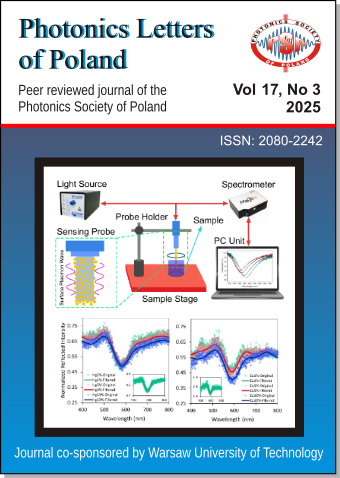Dispersion-Mitigated Variance Reduction in Delay Times and Delay Lengths for Liquid Crystal-Based Variable Delay Lines from 54 GHz to 66 GHz and Beyond
DOI:
https://doi.org/10.4302/plp.v17i3.1351Abstract
Since its inception three decades ago, liquid crystal (LC) microwave phase-shifting technology has made tangible and highly scalable improvements. Although LC-enabled phase shifts (measured in degrees or radians) have arguably produced a wealth of discoveries, delay length and delay duration (measured in picoseconds) have perhaps garnered significantly less attention. In this work, by numerically characterising delay times and lengths of various LC-enabled variable delay line designs at the 60 GHz band, we manage to identify the optimal dielectric constant state (baseline) wherein 50-ohm match is achieved, whilst minimising the spikes and turbulence in the frequency response. In practice, the increase in the conventional figure-of-merit metric (i.e., the ratio of the maximum phase shift to the maximum insertion loss) has coincided with the ripples ramped up in the frequency response of the time delay. By suitably designing the geometry’s matching baseline at the LC’s permittivity state of 3.1, we achieve a quasi-constant delay time (and length) with minimised amplitude variations (standard deviation of 0.72 fs) across 54 GHz to 66 GHz, i.e., highly desirable for minimum squint and mitigated sidelobe for 60 GHz beam steering applications.
Downloads
Published
How to Cite
Issue
Section
License
Copyright (c) 2025 Jinfeng Li, Haorong Li

This work is licensed under a Creative Commons Attribution 4.0 International License.
Authors retain copyright and grant the journal right of first publication with the work simultaneously licensed under a Creative Commons Attribution License that allows others to share the work with an acknowledgement of the work's authorship and initial publication in this journal. Authors are able to enter into separate, additional contractual arrangements for the non-exclusive distribution of the journal's published version of the work (e.g., post it to an institutional repository or publish it in a book), with an acknowledgement of its initial publication in this journal. Authors are permitted and encouraged to post their work online (e.g., in institutional repositories or on their website) prior to and during the submission process, as it can lead to productive exchanges, as well as earlier and greater citation of published work (See The Effect of Open Access).




